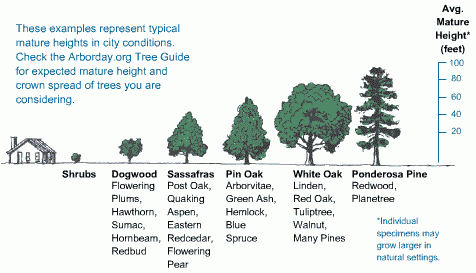It seems like we’ve had to work really hard to persuade spring to appear. But that hasn’t kept gardeners from planning their landscaping for the coming year.
As you look for trees and large landscaping plantings, remember to keep your foundation and house safe as you decide which plants to buy and where to place them.
Finding the right tree
“Trees have very specific site requirements that should be considered before they are given a new home,” John Lang writes for the Arbor Day Foundation.
In addition to sunshine available, soil type and weather, one key factor to consider is your yard’s drainage. “If your yard is sloped, trees and plants at the bottom of your yard will retain more water and may even be prone to drainage issues. Keep this in mind when deciding on the water needs of your future tree,” Lang says.
Another key factor is required growing space. Take a look at where your house is located on your lot, other structures such as decks and sheds, utility lines above and below the ground, and other plants and trees.
“Poor placement can result in roots or branches too close to structures, driveways or sidewalks,” Lang says. This could lead to foundation cracks, damage and leakage in the future.
“You could also run into problems with underground plumbing, or overhead or underground power lines,” he adds.

The Arbor Day Foundation offers a sizing guide (right) that shows the growth heights for certain trees.
If you’re a planting tree to create shade for your house and lower energy bills, position it so it will block the late afternoon sun, according to Jim at YourGardenSanctuary.com. Since afternoon sun shines at a lower angle, “In order to get the most useful shade on a house, you should place a shade tree about 20 feet from the house,” Jim says.
Three big problems can arise if you plant a tree too close to your house:
- You can create hazards, such as branches falling on the house.
- Roots exerting pressure on the foundation can cause mechanical damage.
- Soil moisture can fluctuate, causing soil to contract and expand and put pressure on the foundation.
What not to plant
Roots for certain types of trees grow so aggressively that they shouldn’t be planted even 20 feet or more from your home, according to Jim. They include:
- Silver Maple (Acer saccharinum): Dense and shallow roots can grow into and invade foundations.
- Norway Maple (Acer platanoides): These trees are notorious for lifting and shifting concrete because their roots are near the surface.
- Cottonwoods, Aspens and Poplars (Populus): The wide-spreading root systems of these trees seek out water wherever they can. They are one of the worst to plant near homes.
- Willows (ix spp.): Willow roots will invade your house, water systems and septic systems. The roots grow deep to seek moisture and anchor trees.
- American Elm (Ulmus americana): American Elms have deep roots that often clog sewer lines and drains. These should also be kept well away from anything related to water.
- Two others to avoid near your foundation: Black Alder (Alnus glutinosa) and Black Locust (Robinia pseudoacacia).
What you should plant
So what do experts recommend for planting near your house and foundation? Nikki Phipps at Gardening Know How makes these suggestions.
- Tree-form evergreen shrubs such as wax myrtle, ligustrum or cherry laurel are good for small areas. Keep these at least 5 feet from the house.
- Low-growing shrubs like yew, juniper, boxwood and holly. Allow at least 3 feet between plants to prevent overcrowding.
- Small ornamental trees, such as dogwood, redbud, Japanese map, crepe myrtle and star magnolia.
- Vining plants for ground covers, such as liriope, ivy, creeping juniper, periwinkle and sweet woodruff. Keep these at least 12 inches from the foundation.
Resist the temptation to plant things right next your house to hide your foundation, adds Mike McGrath at Gardens Alive!
“You should always leave a foot of open space around the foundation to prevent moisture build up that can lead to mold and damaging dampness (and to avoid giving insects like carpenter ants and termites direct access to your home),” McGrath says. “Distance is good for the health of the house — and the plants.”
His rule of thumb for next-to-foundation plantings is this: “Take half of a plant’s ‘final width’ and add a foot; that’s close to a perfect rule for most plants.”
If you have questions or concerns about how planting trees and shrubs could affect the drainage in your yard, please call us at 816-741-8500 or contact Dry Basement online. We can check your yard for possible issues with draining and pooling water, and help you make sure your new landscaping won’t cause foundation problems.